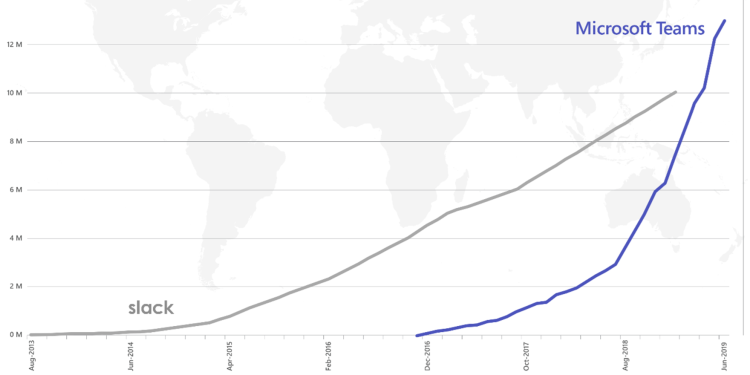testsetset
Microsoft yesterday revealed some new daily active users (DAUs) figures for Microsoft Teams. First, the company said that Microsoft Teams had passed 32 million DAUs, a 60% jump in four months. That was comparable to the last milestone: When Microsoft Teams passed 20 million DAUs, that was an almost 54% jump in four months. But then Microsoft added that a week later, the figure had surged to 44 million DAUs, meaning the roughly four-month increase was closer to 110%. Microsoft directly attributed this surge to a global demand for remote work due to COVID-19.
Yesterday we reached out to Slack to see if the company had an update on its DAUs figure. After all, the last number was from October (12 million DAUs), and the service was likely seeing a similar spike. Slack declined to talk about DAUs, but a spokesperson pointed us to an SEC filing from the same day. Slack had added approximately 7,000 new paid customers from February 1 to March 18, 2020. That represented “a ~40% increase over each of our previous two fiscal quarters, when we added approximately 5,000 new paid customers per quarter.” If the pacing keeps up, Slack could add 180% more paid customers this quarter than it usually does. The briefing didn’t mention COVID-19, but the message was clear: The same surge for global demand was responsible.
None of this should be surprising. Executives are frantically trying to adjust their businesses to weather the storm. IT departments are rolling out new tools and educating employees about existing tools. The COVID-19 pandemic has forced people to rethink what work to prioritize, not just how they should be executing it. Products and services that facilitate connecting people between companies, not just within a company, are inevitably seeing a boom in usage. The question on everyone’s mind: Where will this surge settle?
Slack won’t say, Microsoft is optimistic
That’s exactly what we asked Slack and Microsoft. Slack did not respond to a request for comment by publishing time, but it’s easy to see what the company is hoping. Every SaaS company on the planet tracks its unsubscribe rate. Slack will be working incredibly hard not just to woo more users and sign new business customers, but to ensure the unsubscribe rate doesn’t jump once the current COVID-19 pandemic has concluded. More paid customers with the same unsubscribe rate means net new customers in the long run.
June 5th: The AI Audit in NYC
Join us next week in NYC to engage with top executive leaders, delving into strategies for auditing AI models to ensure fairness, optimal performance, and ethical compliance across diverse organizations. Secure your attendance for this exclusive invite-only event.
Microsoft is thinking the same. “This moment in history is a turning point for how we will work and learn,” Jared Spataro, Microsoft 365 corporate vice president, told VentureBeat. “Teams lets you do more, all in one place. And that remains true whether you’re working from home or your office. Once people start using Teams, it tends to become part of how they work.”
I’m not so sure. Don’t get me wrong — I’m a big believer in the notion that the future of work is remote. The tools are only getting better, and I expect that one day remote work will be the norm. But this is a sugar high — an artificial stimulus.
The only options
Last week, I shared a few work from home tips I have picked up over the years. My colleague Seth Colaner pointed out that I didn’t list any specific tools. That was by design — I told him I didn’t want to open up that can of worms. But the more I thought about it, the more I realized that in many cases, workers don’t have control over the tools they use. They are told which email client, collaboration app, and video conferencing service to use.
The important thing to remember here is that these new users and new customers are showing up because they have to. They aren’t showing up because they want to.
Their government, their employers, or simply their good judgment is telling them not to go into the office. The remote working tool experience is forced. Even if they aren’t working remotely, the person they normally would have met in person probably is. Again, that’s more usage for Slack, Microsoft Teams, Facebook’s Workplace, Google Hangouts, Zoom, Cisco Webex, GoToMeeting, BlueJeans, and all the rest.
There’s plenty to like about each of these solutions, but the surge SaaS companies are seeing can ultimately be attributed to a new problem. If the problem goes away, there will be a period of adjustment. Executives, IT departments, and employees will once again adjust what work to prioritize, and what the best options are to execute that work. Some will continue to use these tools after the COVID-19 pandemic. Others won’t.
They’re on the rise now, but a fall is inevitable. It’s merely a question of how steep that fall will be. Will Microsoft Teams go back to seeing ~60% growth in DAUs every four months? Will Slack go back to adding 5,000 paid customers every quarter? When will that be? There’s a big risk of saturation here. When this is over, everyone who could have tried Microsoft Teams and Slack may have already been forced to adopt it. An unprecedented rise means an unprecedented fall. All these remote tools would be wise to set up some cushions. What the cushions look like will be the other half of the battle — we have no idea what the workforce will look like when this is over, nor do we know when it will be over.
ProBeat is a column in which Emil rants about whatever crosses him that week.

